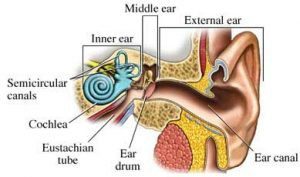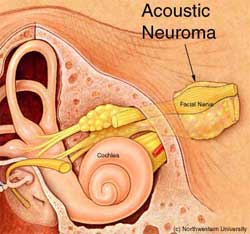…and how it affects your tinnitus
By Shauna Scott
Quiet Times Staff Writer
 Driving up a canyon, taking off in an airplane, swimming completely submerged… all of these things can make us take note of pressure in the inner ear. When this pressure can’t be relieved in the normal manner, the result is ear fullness. The sensation of ear fullness (or aural fullness), is sometimes accompanied by other symptoms, including muffled hearing, tinnitus, vertigo, pain, tenderness or itching, fever, and discharge or drainage from the ear.
Driving up a canyon, taking off in an airplane, swimming completely submerged… all of these things can make us take note of pressure in the inner ear. When this pressure can’t be relieved in the normal manner, the result is ear fullness. The sensation of ear fullness (or aural fullness), is sometimes accompanied by other symptoms, including muffled hearing, tinnitus, vertigo, pain, tenderness or itching, fever, and discharge or drainage from the ear.
The inner ear is isolated from the environment by the eardrum on one side and the Eustachian Tube on the other. A yawn, swallowing, or chewing gum can relieve pressure in the ear by briefly opening the Eustachian Tube and allowing the pressure inside the ear to equalize with the outside. In most cases, ear fullness is caused by something as simple as congestion from a cold or hay fever, a mild infection, or even earwax build-up. These common causes are easily treated. Occasionally aural fullness is an indicator that one should seek medical treatment for a more dangerous underlying cause.
1 – Ear infections
Otitis externa
Sometimes called swimmers ear (or otomycosis in the case of fungal infection) Otitis externa is an infection of the ear canal. Symptoms include itching, pain, discharge from the ear, a feeling of fullness, tinnitus, and muffled hearing. “…predisposing factors include a lack of healthy earwax, or trauma to the ear, both of which can be caused by improper cleaning.” * Having your doctor thoroughly clean and dry the affected ear, followed by anti-fungal medications or antibiotics is generally effective treatment.
 Otitis media
Otitis media
Otitis media is an infection or inflammation of the middle ear. This is a common ailment in infants and children, but it can affect people in all age ranges. It often presents with fever and pain, and can come on quite suddenly. Antibiotics and over-the-counter pain medication usually take care of the problem. There are different causes, like Eustachian tube dysfunction (which is discussed in more detail below,) and sometimes this condition will resolve itself spontaneously. A proper diagnosis by a qualified health care professional will ensure that unnecessary antibiotics are avoided.
2 – Endolymphatic Hydrops
If aural fullness is caused by an imbalance of fluid in the inner ear, it is called Endolymphatic Hydrops. Hydrops is an accumulation of excess fluid in tissues or cavities of the body.(1) The endolymph is the fluid contained in the labyrinth of the inner ear, which is normally maintained at a constant volume, and with a specific composition of electrolytes.
“This fluid bathes the sensory cells of the inner ear and allows them to function normally. In an inner ear affected by hydrops, these fluid-system controls are believed to be lost or damaged… Symptoms typical of hydrops include pressure or fullness in the ears (aural fullness), tinnitus (ringing or other noise in the ears), hearing loss, dizziness, and imbalance.”(2)
Meniere’s disease – or Primary or idiopathic endolymphatic hydrops
Meniere’s disease has established symptoms, but an underlying cause for the symptoms is unknown. In order to confirm a diagnosis of Meniere’s disease, there must be recurring episodes of vertigo, tinnitus, aural fullness, and some degree of hearing loss.(3) The first sign of a Meniere’s episode is often aural fullness. This would be followed by increasing tinnitus and vertigo. Episodes last anywhere from 20 minutes to two days. Almost all people diagnosed with Meniere’s disease will end up with some permanent hearing loss. “Although Meniere’s disease is considered a chronic condition, various treatment strategies can help relieve symptoms and minimize the disease’s long-term impact on your life.”(4)
Secondary endolymphatic hydrops (SEH)
SEH has all the same symptoms as Meniere’s disease, but the underlying cause of the symptoms is known, as in the case of a head trauma or ear surgery, and these symptoms tend to be more continuous than in the case of Meniere’s disease. Luckily there are treatment options to reduce the severity of the symptoms. Many people with SEH find relief from a balanced diet that minimizes sugar and salt intake. Proper hydration is also key to relieving or reducing symptoms.(2)
3 – Impacted Earwax
Sometimes the feeling of fullness is caused by actual ear fullness. earwax, or cerumen, is important to your aural health. It lubricates the auditory canal, and helps prevent dust, hair, and other particulates from penetrating the canal too deeply. When earwax builds up, it can cause muffled hearing or “partial hearing loss, earache, tinnitus, odor, itching, fullness in the ear, and coughing.”(5) When earwax is suspected as a culprit in these symptoms, it is a good idea to remove the build-up. Cotton swabs are not a good option, because most of the time, they just end up pushing the earwax in further. Instead try a home remedy, like a few drops of a solution of hydrogen peroxide and water, a few drops of baby oil or olive oil, or a little saline solution. Any of these dripped into the ear canal and left for a few minutes, followed by draining the solution into a towel, can help soften the earwax, so it can be expelled in a normal fashion. If this method doesn’t help, see a health-care provider to have excess earwax removed in order to avoid damaging the sensitive ear canal and eardrum.
4 – Cholesteatoma
In patients with a history of Eustachian tube dysfunction, chronic ear infections, or in people who have had a ruptured eardrum, a cholesteatoma can develop. It is a benign cyst, filled with dead skin cells. When a feeling of fullness in the ear is accompanied by drainage, often foul smelling, and one or more of the following symptoms: dizziness, pain, hearing loss, or muscle weakness in facial muscles on the same side as the infection, it’s a good idea to seek medical diagnosis. The cyst will often require antibiotics to eliminate infection, followed by surgery to remove the growth. In aggressive cases, the cyst can cause infection in the bones that protect the brain, or the bones of the inner ear, leading to permanent hearing loss, or in extreme cases, meningitis. (6)
5 – Tensor Tympani Syndrome
The tensor tympani muscle, located in the middle ear, tightens the connections in the middle ear to dampen sound and protect the inner ear from loud harmful noise. In patients suffering from hyperacusis, the tensor tympani muscles can be activated even if the patient just thinks about a loud sound.
“Hyperacusis is a condition of extreme sensitivity to sounds. People who suffer from hyperacusis experience ordinary sounds as being unbearably loud. Those who develop severe cases often go to great lengths to diminish the impact of environmental sounds, including moving to new homes, purchasing quieter vehicles or isolating themselves socially.”
Excerpted from “Hyperacusis and Tinnitus” by Barry Keate
Patients with hyperacusis develop a reflex that triggers the tensor tympani, even in situations where the sound that is present is not loud enough to be harmful, resulting in tonic tensor tympani syndrome (TTTS.) The tensor tympani muscle actually pulls on the eardrum, causing the pressure inside the ear to increase. The best way to manage this condition is with reconditioning therapy, which includes counseling and a desensitization program to help the patient increase his or her tolerance for normal sound levels. (7)
6 – Superior Semicircular Canal Dehiscence Syndrome (SCDS)
Superior semicircular canal dehiscence syndrome stems from a small hole in a bone of the inner ear that covers the superior semicircular canal. This canal is one of three that senses head movement, acceleration, and balance. Major complaints of SCDS include dizziness or vertigo and some hearing loss.
“Patients are most often in their 30s and 40s and usually complain of dizziness and vertigo usually triggered by straining, heavy lifting, sexual activity, bowel movements or child birth, or loud (usually low frequency) sounds. Other common complaints included fullness in the ear, an echoing or reverberation sensation of the ear during speaking, walking, chewing, or swallowing, and/or hearing loss.”(6)
Often when a patient becomes aware of this disorder, they are able to avoid, or reduce exposure to, things that trigger vertigo or dizziness. If conservative therapies fail to manage symptoms, a surgical procedure is an option, but it is very invasive and exposes the brain in order to repair the damaged bone.(6)
7 – Sudden Sensorineural Hearing Loss (SSHL)
Sudden sensorineural hearing loss (SSHL) occurs infrequently; only 1 in 10,000-15,000 people will be affected by this condition. It typically takes only minutes or days to present, and should be considered a medical emergency. (6) Often the sudden deafness is preceded by a “pop” and then the patient notices fullness of the ear, dizziness, or tinnitus. There are over 100 causes for SSHL, and the sooner a patient seeks medical treatment, the better their chances for recovering lost hearing.(8)
8 – Eustachian Tube Dysfunction
In a person with Eustachian tube dysfunction (or ETD) the Eustachian tube fails to open during chewing, swallowing, or yawning. Because of this, pressure in the ear fails to equalize with outside air pressure. This leads to a feeling of fullness in the ear, tinnitus, pain, or dizziness. ETD occurs most often in children because the size and angle of the Eustachian tube in their smaller heads makes it more difficult for fluids to drain from the inner ear. When ETD is present, the sufferer will often say that temporary relief can occur with normal processes, such as swallowing, but the ear quickly becomes “full” again. There are numerous causes of ETD, many involve chronic infection of the ears or sinuses. Sometimes decongestants, antihistamines, or steroids are effective treatment. During diagnosis, it is important to rule out possible underlying causes like TMJ or migraine headache.
9 – Acoustic Neuroma
 Acoustic Neuroma is a noncancerous growth on the eighth cranial nerve. This nerve helps with balance and sound transmission to the brain. Acoustic neuroma is a rare, slow growing, and non-malignant. Symptoms include gradual hearing loss in one ear, tinnitus, aural fullness, balance issues, and eventually facial tingling or numbness, headaches, and clumsiness or confusion.(9) Because these tumors are slow-growing and benign, often the first line of defense is observation. Once the growth becomes large enough to impinge on nerves that control the facial muscles or the brain stem, surgical procedures or radiation therapy are good options for treatment, although there is often a permanent loss of hearing in the affected ear.
Acoustic Neuroma is a noncancerous growth on the eighth cranial nerve. This nerve helps with balance and sound transmission to the brain. Acoustic neuroma is a rare, slow growing, and non-malignant. Symptoms include gradual hearing loss in one ear, tinnitus, aural fullness, balance issues, and eventually facial tingling or numbness, headaches, and clumsiness or confusion.(9) Because these tumors are slow-growing and benign, often the first line of defense is observation. Once the growth becomes large enough to impinge on nerves that control the facial muscles or the brain stem, surgical procedures or radiation therapy are good options for treatment, although there is often a permanent loss of hearing in the affected ear.
10 – Labrynthitis
Labrynthitis is an inflammation of the inner ear, usually resulting from a viral infection and affecting the nerves responsible for both balance and hearing.(10)
“Symptoms of labrynthitis typically include the acute onset of vertigo that can last hours to days and can be accompanied by nausea, vomiting, and imbalance. Hearing loss often occurs at the same time as the vertigo or shortly after, and can be heralded by loud tinnitus, pressure, or pain in the ear. These symptoms often occur following another illness such as an upper respiratory infection, ear infection, or the flu.” (6)
Most of the time, the symptoms of labrynthitis resolve without medical interference, usually over the course of several weeks. If vertigo is severe, anti-emetics or sedatives might be prescribed to help control the resulting vomiting. Steroids might also be prescribed to shorten overall recovery time.
Conclusion
Next time you jump on a ski lift, don’t forget your chewing gum. If this proven remedy doesn’t keep your ears clear, there might be more at stake than muffled hearing and the resulting awkward conversation. Most cases of aural fullness resolve on their own, even childhood ear infections are treated less frequently with antibiotics. However, if your case of ear fullness is persistent and accompanied by dizziness, vertigo, pain, or fever, then a consultation with your doctor is probably a good idea.
Learn about Sudden Brief Tinnitus >
References:
1) The American Heritage® Stedman’s Medical Dictionary. Retrieved January 22, 2015, from Dictionary.com website: http://dictionary.reference.com/browse/hydrops
2) Pesznecker, Susan, RN. Secondary Endolymphatic Hydrops. Vestibular.org. Vestibular Disorders Association. n.d. Web. (4, Dec., 2014)
3) Meniere’s Disease. entnet.org. American Academy of Otolaryngology-Head and Neck Surgery. n.d. Web. (28, Jan., 2015)
4) Mayo Clinic Staff. Meniere’s Disease. Mayoclinic.org. Meniere’s Disease Symptoms – Diseases and Conditions. n.d. Web. (28 Jan., 2015)
5) Ear Wax Removal. Md-health.com. MD Health.com. n.d. Web. (15, Jan., 2015)
6) Patient Education. denverear.com. EducatedPatients.com. 2012. Web. (4, Dec., 2014)
7) Wescott, Myriam. Tensor Tympani Syndrome. hyperacusis.net. The Hyperacusis Network. 2013. Web. (9, Jan., 2015)
8) Sudden Deafness. nidcd.nih.gov. National Institute on Deafness and Other Communication Disorders. Nov. 2013. Web. (2, Feb., 2015)
9) Acoustic Neuroma. WebMD.com. WebMD. n.d. Web. (20, Jan., 2015)
10) Labrynthitis and Vestibula Neuritis- Topic Overview. WebMD.com. WebMD. n.d. Web. (28, Jan., 2015)
Get Free Shipping!
Order now and get free shipping on either the Tinnitus Starter Kit or Combo Pack. Try the doctor recommended products with clinically proven ingredients for tinnitus. No coupon code required.

